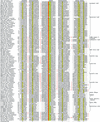Detection of novel members, structure-function analysis and evolutionary classification of the 2H phosphoesterase superfamily
- PMID: 12466548
- PMCID: PMC137960
- DOI: 10.1093/nar/gkf645
Detection of novel members, structure-function analysis and evolutionary classification of the 2H phosphoesterase superfamily
Abstract
2',3' Cyclic nucleotide phosphodiesterases are enzymes that catalyze at least two distinct steps in the splicing of tRNA introns in eukaryotes. Recently, the biochemistry and structure of these enzymes, from yeast and the plant Arabidopsis thaliana, have been extensively studied. They were found to share a common active site, characterized by two conserved histidines, with the bacterial tRNA-ligating enzyme LigT and the vertebrate myelin-associated 2',3' phosphodiesterases. Using sensitive sequence profile analysis methods, we show that these enzymes define a large superfamily of predicted phosphoesterases with two conserved histidines (hence 2H phosphoesterase superfamily). We identify several new families of 2H phosphoesterases and present a complete evolutionary classification of this superfamily. We also carry out a structure- function analysis of these proteins and present evidence for diverse interactions for different families, within this superfamily, with RNA substrates and protein partners. In particular, we show that eukaryotes contain two ancient families of these proteins that might be involved in RNA processing, transcriptional co-activation and post-transcriptional gene silencing. Another eukaryotic family restricted to vertebrates and insects is combined with UBA and SH3 domains suggesting a role in signal transduction. We detect these phosphoesterase modules in polyproteins of certain retroviruses, rotaviruses and coronaviruses, where they could function in capping and processing of viral RNAs. Furthermore, we present evidence for multiple families of 2H phosphoesterases in bacteria, which might be involved in the processing of small molecules with the 2',3' cyclic phosphoester linkages. The evolutionary analysis suggests that the 2H domain emerged through a duplication of a simple structural unit containing a single catalytic histidine prior to the last common ancestor of all life forms. Initially, this domain appears to have been involved in RNA processing and it appears to have been recruited to perform various other functions in later stages of evolution.
Figures






References
-
- Aravind L. and Koonin,E.V. (1998) The HD domain defines a new superfamily of metal-dependent phosphohydrolases. Trends Biochem. Sci., 23, 469–472. - PubMed
-
- Aravind L. (1999) An evolutionary classification of the metallo-beta-lactamase fold proteins. In Silico Biol., 1, 69–91. - PubMed
-
- Aravind L. and Koonin,E.V. (1998) A novel family of predicted phosphoesterases includes Drosophila prune protein and bacterial RecJ exonuclease. Trends Biochem. Sci., 23, 17–19. - PubMed
-
- Koonin E.V. and Tatusov,R.L. (1994) Computer analysis of bacterial haloacid dehalogenases defines a large superfamily of hydrolases with diverse specificity. Application of an iterative approach to database search. J. Mol. Biol., 244, 125–132. - PubMed
MeSH terms
Substances
LinkOut - more resources
Full Text Sources
Molecular Biology Databases

